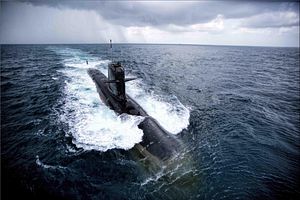Indian Prime Minister Narendra Modi commissioned the INS Kalvari, the first of six planned Scorpene-class (Kalvari-class) diesel-electric attack submarines (SSK), into the Indian Navy at the naval dockyard in Mumbai on December 14.
The Indian government awarded French shipbuilder Naval Group (formerly known as Direction des Constructions Navales Services ) a $4.16 billion contract for the construction of six diesel-electric attack submarines for the Indian Navy in partnership with Mumbai-based Mazagon Dock Limited under the so-called Project-75 acquisition program.
Modi described the INS Kalvari as a prime example of the “Make in India” initiative adding that the commissioning of the new SSK is an excellent illustration of the fast growing strategic partnership between India and France. In his remarks, Modi also emphasized the importance of the Indian Ocean for Indian security.
The 1,565-ton INS Kalvari was launched in October 2015 and was first put to sea in May 2016. The commissioning date was first set for August or early September but had to be pushed to December due to longer than expected operational trials. The Indian Ministry of Defense’s (MoD) entire Project-75 has been delayed by over four years.
The INS Kalvari will be the Indian Navy’s most technologically advanced SSK ever commissioned. According to the Indian MoD, boat’s hull form, fin and hydroplanes are specifically designed to produce minimum underwater resistance. While underwater, the SSK is powered by 360 battery cells and a permanently magnetized propulsion motor.
“The boat also has her two 1250 kW MAN Diesel Engines for rapidly charging batteries,” the Indian MoD said in a statement. The new SSK will not be fitted with an air-independent propulsion (AIP) system for the time being. Yet, there are plans to retrofit the boat with a domestically designed and built AIP in the future, along with the remaining five boats of the class.
The SSKs operational range is around 6,500 nautical miles (around 12,000 kilometers).
The Kalvari’s is armed with “a cluster of advanced weapons and sensors integrated into the Submarine Tactical Integrated Combat System (SUBTICS),” according to the MoD. The boat will be armed with French-made Exocet SM39 anti-ship missile, a sea-skimming, subsonic, solid-fueled anti-ship missile with an estimated operational range of 50-70 kilometers, designed to attack small- to medium-size warships.
“Towards self-defence, she is fitted with mobile C303/S anti-torpedo decoys,” the MoD states. While the MoD statement notes that the Kalvari will be armed with heavy weight wire guided surface and underwater target torpedoes, the Indian Navy has so far not procured any as it cancelled an order for Black Shark heavyweight torpedoes.
The Black Shark’s manufacturer, Whitehead Alenia Systemi Subacquei (WASS), a subsidiary of Italian arms manufacturer Finmeccanica, has been under investigation by the Indian government over corruption allegations involving defense deals.
“The Black Shark torpedo was specifically purchased for the Indian Navy’s future fleet of six Scorpene-class (Kalvari-class) diesel-electric attack submarines,” I reported elsewhere. “A second batch of 49 Black Shark torpedoes was also to be installed aboard India’s domestically developed and built Arihant-class of nuclear-powered ballistic missile submarines.”
The Indian Navy is likely to opt for German-made SeaHake heavyweight torpedo or French F21 Artemis instead. The boat is able to carry up to 18 anti-ship missiles or heavy-weight torpedoes.
The boats crew consists of eight officers and 35 sailors.































